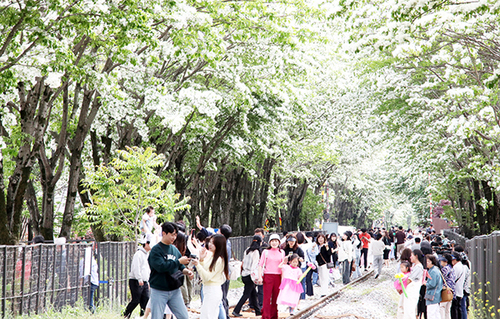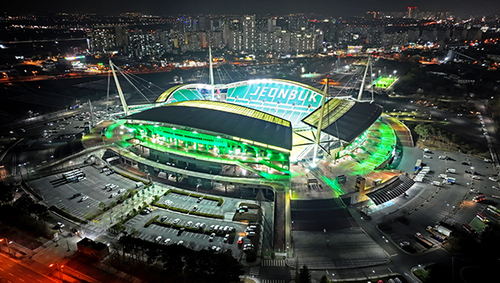| ▲ 전북지역 민영방송인 JTV 전주방송이 창사특집으로 기나긴 논쟁에 무게 추를 더할 만한 다큐멘터리 '익산은 정말 백제의 수도 였을까'를 오는 25일 오후 11시에 방영한다. / 사진제공 = JTV 전주방송 미디어전략심의팀 © 김현종 기자 |
|
전북지역 민영방송인 JTV 전주방송이 창사특집으로 기나긴 논쟁에 무게 추를 더할 만한 다큐멘터리 '익산은 정말 백제의 수도 였을까'를 방영한다.
오는 25일 오후 11시에 방송될 이 다큐멘터리 진행자로 나선 백제 전문가 최완규(원광대 마한백제문화연구소) 교수가 현장을 직접 누비며 생동감 있는 화면과 함께 전하는 메시지가 인상적이다.
특히, 유방의 탄생설화를 비롯 다양한 3D 애니메이션과 실사 위에 건물을 복원하는 와이어 그래픽스 및 웅장한 스케일의 재연은 이 프로그램에 들인 공력을 짐작케 한다.
동아시아에서 확인된 왕궁터의 원형으로 평가받는 익산 왕궁리 유적과 백제 최대 규모를 자랑하는 호국사찰 미륵사ㆍ일본에서 발견된 천도 기사ㆍ왕실 사찰인 제석사지 유물은 백제의 '익산시대'를 말해주는 단서로 한동안 회자돼 왔다.
하지만, 익산이 백제의 수도였다는 주장에 힘을 실어줄 결정적인 유물이나 유적이 한동안 발견되지 않았으나 최근 발굴을 통해 익산 쌍릉의 주인공이 백제 무왕과 왕비라는 사실이 드러났다.
여기서 눈여겨볼 점은 익산에 2기의 능원이 조성됐다는 점이다.
또 하나 눈여겨볼 만한 대목이 있다.
삼국유사에 남아있는 무왕의 탄생설화다.
수도 남쪽의 연못에서 용과 하룻밤을 보내고 낳은 이가 훗날 왕이 되는 서동이라는 이야기는 중국 한나라를 건국한 유방의 탄생설화와 똑같은 서사구조를 갖고 있다.
그렇다면, 역사는 왜 백제 30대 왕위에 오른 무왕을 개국시조에 비견할 만한 인물로 묘사하고 있는 것일까?
혹시, 사비가 아닌 새로운 수도 익산에서 건국에 버금가는 새로운 백제를 만들고자 했던 것은 아닐까라는 추측도 가능하다.
프로그램 진행자로 나선 최완규 교수는 "삼국의 예를 통해 살펴보면 이렇게 왕들의 무덤인 능원이 수도가 아닌 곳에 만들어진 경우는 없다"라고 단언하며 "구전으로만 전해져 왔던 무왕과 왕비의 무덤이, 익산이 무왕의 도시임을 증거 하는 것"이라고 설명했다.
연출을 맡은 김균형 PD는 "자신은 백제 수도를 중심으로 '한성백제ㆍ웅진백제ㆍ사비백제'로 배운 세대이자 여전히 아이들도 그렇게 배우고 있는 것이 현실"이라며 "앞으로 익산 백제가 교과서에 실리는 날까지 꾸준히 관심을 갖고 후속 프로그램을 제작하고 싶다"는 포부를 밝혔다.
☞ 아래는 위 기사를 구글 번역기로 번역한 영문 기사의 전문이다.
Below is the full text of an English article translated from the above article with Google Translate.
JTV Jeonju Broadcasting, a private broadcaster in the Jeonbuk region, airs a documentary ‘Is Iksan Really the Capital of Baekje?’
The message delivered by Baekje expert Choi Wan-gyu (Mahan Baekje Culture Research Institute), who will be broadcast at 11 pm on the 25th, goes directly to the site and conveys the message along with the lively screen.
In particular, various 3D animations, including the birth story of breasts, wire graphics that restore buildings on a live-action scene, and a magnificent scale re-enactment give you a sense of the power of the program.
The remains of Wanggung-ri in Iksan, which are considered the prototype of royal palaces identified in East Asia, and Mireuksa, the largest guardian temple in Baekje. It has been talked about for a while.
However, no decisive relics or ruins were discovered for a while that would power the claim that Iksan was the capital of Baekje, but recent excavations revealed that the main characters of the Iksan Ssangneung were King Mu and Queen Paekje.
What is worth noting here is that the 2nd Neungwon was built in Iksan.
There is another point worth noting.
This is the story of the birth of King Mu remaining in the Three Kingdoms.
The story of Seo-dong, who later became king after spending one night with a dragon in a pond in the south of the capital, has the same narrative structure as the birth story of Weifang, the founder of the Chinese Han Dynasty.
Then, why does history describe King Mu, who became the throne in the 30s of Baekje, as a person comparable to the founding of the nation?
It is also possible to speculate that he was trying to create a new Baekje comparable to the founding of the country in Iksan, a new capital, not Sabi.
Prof. Wan-gyu Choi, who served as the program host, asserted, "Looking at the example of the Three Kingdoms, there is no case where the tomb of the kings was built outside of the capital." It is proof that it is a city.
PD Kim Gyun-hyeong, who was in charge of directing, said, "It is a generation that I learned as'Hanseong Baekje, Woongjin Baekje, and Sabi Baekje' centering on the Baekje capital, and it is a reality that children are still learning that way." I am interested and want to produce a follow-up program."




















 많이 본 뉴스
많이 본 뉴스











